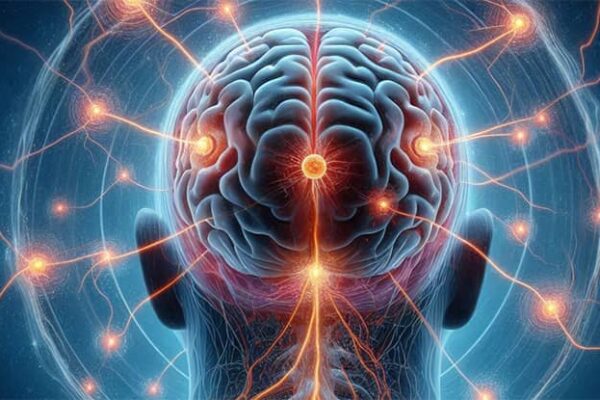We all experience anxiety at certain moments in life—before an important event, in stressful situations, or when facing uncertainty. Anxiety is a normal human emotion that helps us mobilize resources to overcome challenges. However, for some people, anxiety becomes excessive and interferes with their ability to live their lives.
Generalized Anxiety Disorder (GAD) is a chronic mental condition characterized by uncontrollable worry and anxiety about a wide range of situations and life circumstances. People with GAD constantly experience irrational fears about various aspects of everyday life, such as work, finances, health, or interpersonal relationships. This persistent anxiety makes it difficult to concentrate, disrupts sleep, and can severely affect the quality of life.
According to the U.S. National Institute of Mental Health (NIMH), about 6.8 million American adults (or 3.1% of the population) are affected by GAD each year. The prevalence of GAD is roughly equal among men and women and typically begins in early adulthood. If left untreated, this disorder can lead to serious consequences for both mental and physical health, as well as difficulties in daily life.

Symptoms of Generalized Anxiety Disorder
GAD is characterized by persistent excessive anxiety and worry that significantly impacts a person’s daily activities. The main distinguishing feature of GAD is that the anxiety is not limited to a specific situation or object but extends to multiple aspects of life.
People with generalized anxiety disorder constantly experience irrational concerns related to work, finances, health, relationships, and much more. They tend to expect the worst outcomes and worry about events over which they have little or no control. This chronic anxiety is accompanied by a range of mental and physical symptoms.
Symptoms of GAD vary from person to person but usually include a combination of cognitive, emotional, and somatic manifestations. Below are the most common signs of GAD to watch out for in order to diagnose and treat this condition in a timely manner.
Chronic Worry and Anxiety:
- Feeling “on edge” or restless, with difficulty calming down.
- Trouble concentrating due to persistent, intrusive anxious thoughts.
- Constantly expecting the worst and having catastrophic fears about the future.
- Inability to relax or distract oneself from worries.
Irritability and Short Temper:
- Sudden bursts of anger or frustration.
- Impatience and low stress tolerance.
- Feeling “on edge,” with heightened sensitivity to criticism.
Insomnia and Sleep Disturbances:
- Difficulty falling asleep due to racing thoughts.
- Poor sleep quality, with frequent nighttime awakenings.
- Shallow or non-restorative sleep.
Physical Symptoms of Anxiety:
- Muscle tension, cramps, or chronic muscle pain.
- Rapid heartbeat, excessive sweating.
- Dry mouth.
- Tension headaches or migraines.
- Nausea, bloating, or diarrhea.
- Numbness or tingling sensations in the hands and feet.
While these symptoms are characteristic of GAD, their combination and severity can vary from person to person. In any case, if excessive anxiety and worry persist for a long time and significantly affect the quality of life, it’s essential to consult a specialist.
Causes of Generalized Anxiety Disorder
Generalized anxiety disorder has a complex etiology, involving the interaction of multiple genetic, biological, psychological, and environmental factors. Researchers continue to actively study the mechanisms behind the development of this disorder to better understand its nature and develop more effective treatments.
Modern scientific data suggests that GAD is likely the result of imbalances in certain neurochemical systems in the brain that regulate emotions, stress, and anxiety. In addition, genetic factors can predispose some individuals to develop GAD when exposed to certain environmental triggers. Let’s take a closer look at the primary causes and risk factors for this common anxiety disorder.
Genetic Factors
Studies indicate that people who have close relatives with anxiety disorders are at a higher risk of developing GAD themselves, suggesting a genetic predisposition to the disorder.
Researchers have identified several genes that may influence the functioning of neurotransmitters (such as serotonin, norepinephrine, and GABA), which regulate mood and stress responses. Polymorphisms or mutations in these genes are linked to an increased vulnerability to anxiety disorders.
Neurochemical Imbalance
As with other mental disorders, an imbalance in specific chemicals (neurotransmitters) in the brain is considered a key factor contributing to the development of GAD.
Imbalances in the levels of serotonin, norepinephrine, and GABA—which regulate mood, emotions, and stress response—can lead to hyperactivity in brain areas responsible for processing anxiety signals. This, in turn, may result in excessive worry and anxiety.
Additionally, structural and functional changes in specific brain regions, such as the amygdala and prefrontal cortex, may also play a role in the pathophysiology of GAD.
Stressful Life Events
Stressful or traumatic life events often serve as triggers for the development of generalized anxiety disorder in genetically predisposed individuals.
Potential GAD triggers may include:
- The death of a loved one.
- Divorce or relationship breakdown.
- Job loss or financial difficulties.
- Serious illness or injury.
- Major life changes or other significant life upheavals.
Chronic stress at work, in family life, or in interpersonal relationships can also contribute to the development of GAD symptoms. People who have experienced traumatic childhood events, such as abuse, neglect, or violence, are also at higher risk for GAD.
Comorbid Medical Conditions
Certain physical illnesses and conditions can cause symptoms similar to anxiety or worsen pre-existing anxiety disorders. These include:
- Thyroid disorders (hyperthyroidism and hypothyroidism).
- Diabetes.
- Chronic pain syndromes.
- Cardiovascular diseases.
- Attention Deficit Hyperactivity Disorder (ADHD).
- Side effects of certain medications.
Therefore, when diagnosing GAD, it’s important to rule out other possible medical causes through appropriate testing.
Personality Traits and Cognitive Patterns
Psychological factors, such as personality traits, thinking styles, and coping strategies, also play a role in the development of generalized anxiety disorder.
Some personality traits linked to an increased risk of GAD include:
- Perfectionism and unrealistically high standards.
- Negative thinking and a tendency to catastrophize.
- Low self-esteem and insecurity.
- High levels of neuroticism and emotional instability.
Additionally, individuals with GAD often display unhealthy cognitive patterns, such as excessive worry about the future, overgeneralization, and interpretation errors. They tend to focus too much on potential threats and negative outcomes, while ignoring more positive or realistic possibilities.

Diagnosis of Generalized Anxiety Disorder
Accurate and timely diagnosis of GAD is crucial for proper treatment and the prevention of long-term negative outcomes. However, diagnosing GAD can be challenging since its symptoms often overlap with other anxiety disorders, clinical depression, and even some physical illnesses.
There is no single laboratory or instrumental test that can definitively confirm the presence of GAD. Instead, physicians and mental health professionals rely on a thorough clinical evaluation of symptoms, the patient’s medical and psychological history, and the use of standardized diagnostic criteria and scales. Let’s explore the process of diagnosing GAD and the various approaches used by specialists.
DSM-5 Diagnostic Criteria
According to the Diagnostic and Statistical Manual of Mental Disorders (DSM-5), the following criteria must be met for a GAD diagnosis:
- Excessive worry and anxiety occurring more days than not, for at least 6 months.
- Difficulty controlling the worry.
- The anxiety is associated with multiple events or activities (work, family, etc.).
- At least three of the following six symptoms must be present:
- Irritability.
- Muscle tension.
- Sleep disturbances.
- Difficulty concentrating.
- Fatigue.
- Restlessness or feeling on edge.
- The symptoms cause clinically significant distress or impairment in social, occupational, or other important areas of functioning.
- The disorder is not caused by the physiological effects of substances (medications, alcohol) or other medical conditions.
Distinguishing Between Normal and Pathological Anxiety
It’s important to recognize that anxiety itself is normal and adaptive. It helps people mobilize resources to cope with stress or danger. Anxiety becomes pathological when it is excessively intense, persistent, and negatively impacts daily life.
Specialists consider the following criteria to differentiate between normal and pathological anxiety:
- The degree of excessive worry compared to the actual situation.
- The ability to manage daily tasks and responsibilities despite the anxiety.
- The persistence and duration of symptoms.
- The presence of significant physical symptoms (rapid heartbeat, sweating, etc.).
- Disrupted sleep and cognitive functioning.
- The level of distress and suffering caused by the anxiety.
If anxiety becomes excessive, constant, and significantly worsens the quality of life, it may indicate GAD or another anxiety disorder.
Role of Specialists in Diagnosis
The diagnosis of GAD typically begins with a visit to a primary care physician, such as a general practitioner or family doctor. They may conduct an initial screening to rule out possible physical causes of the symptoms.
The patient is then usually referred to a psychiatrist, clinical psychologist, or another mental health professional for further evaluation. These specialists use structured clinical interviews, questionnaires, and tests to assess the symptoms of anxiety.
Other medical specialists may also be involved in the diagnostic process to rule out comorbid physical illnesses. For example, an endocrinologist may assess thyroid function, or a cardiologist may rule out heart issues.
Accurate diagnosis is crucial because GAD can coexist with other mental health disorders, such as depression, eating disorders, or substance use disorders.

Treatment of Generalized Anxiety Disorder
Today, generalized anxiety disorder (GAD) is considered one of the most successfully treatable anxiety disorders. Modern medicine offers effective therapeutic methods that can significantly alleviate GAD symptoms and improve the quality of life for patients.
The treatment of generalized anxiety disorder usually involves a combination of psychotherapeutic interventions and, in some cases, the use of medications.
The choice of a specific treatment plan is based on factors such as the severity of symptoms, the presence of comorbid disorders, the patient’s individual preferences, and the availability of certain types of therapy. Below are well-established methods for treating GAD.
Psychotherapy
Psychotherapy is considered one of the main methods for treating generalized anxiety disorder. It focuses on changing negative thinking and behavioral patterns underlying excessive anxiety.
The most effective type of psychotherapy for GAD is cognitive-behavioral therapy (CBT), which includes the following techniques:
- Cognitive restructuring – identifying and replacing irrational, catastrophic thoughts with more realistic and adaptive ones.
- Exposure therapy – gradually and systematically engaging in anxiety-provoking situations to overcome fears.
- Relaxation techniques – meditation, progressive muscle relaxation, visualization, diaphragmatic breathing.
- Stress management skills training – planning, problem-solving, time management, etc.
Other types of psychotherapy, such as acceptance and commitment therapy, psychodynamic psychotherapy, and supportive psychotherapy, can also be used in combination with CBT or on their own.
Medication Therapy
The following groups of medications are commonly prescribed for the pharmacological treatment of generalized anxiety disorder:
- Antidepressants:
- Selective serotonin reuptake inhibitors (SSRIs), such as paroxetine, escitalopram, sertraline.
- Dual-action antidepressants affecting serotonin and norepinephrine (venlafaxine, duloxetine).
- Anxiolytics (tranquilizers):
- Benzodiazepine group medications (alprazolam, clonazepam, diazepam) can quickly relieve anxiety symptoms. However, due to the risk of addiction and dependency, they are typically prescribed for short periods.
- Antiepileptic medications:
- Pregabalin and gabapentin can be effective in treating anxiety disorders, including GAD.
Medication therapy is often used in combination with psychotherapy, especially in the early stages, to achieve better control over anxiety symptoms. After the patient’s condition stabilizes, medications may be gradually discontinued under a doctor’s supervision.
Lifestyle Changes
In addition to professional treatment, lifestyle changes can help reduce generalized anxiety disorder symptoms and improve overall well-being. The following are recommended:
- Regular physical exercise. Aerobic activities (walking, running, swimming) and yoga can reduce anxiety and depression.
- Healthy eating. Avoid caffeine, alcohol, and foods high in sugar, as they can exacerbate symptoms. Eat more whole, nutrient-rich foods.
- Good sleep hygiene. Maintain a regular sleep schedule, create a calming bedroom environment, and avoid electronic gadgets before bedtime.
- Relaxation techniques. Practice mindfulness meditation, breathing exercises, progressive muscle relaxation.
- Stress management. Identify sources of stress and learn methods for reducing it (delegation, planning, hobbies).
- Social support. Interact with loved ones, family members, and friends to help cope with anxiety.
These changes can complement traditional GAD treatment or be used as standalone methods for supporting mental health.

Consequences of Untreated Generalized Anxiety Disorder
Despite the availability of effective treatments, generalized anxiety disorder often goes undiagnosed and untreated. Experts estimate that only about 25% of people with GAD receive proper care. Ignoring symptoms and avoiding treatment can have serious negative consequences for many aspects of a person’s life.
Chronic, uncontrolled anxiety and worry, characteristic of untreated GAD, can significantly reduce a person’s functionality and well-being. Additionally, persistent symptoms of generalized anxiety disorder increase the risk of developing a wide range of comorbid mental and physical health issues. The progressive and prolonged nature of the disorder can also negatively impact social relationships, professional activities, and financial well-being.
Impact on Quality of Life
One of the most obvious consequences of GAD is a significant reduction in quality of life and subjective well-being:
- Constant feelings of worry, tension, and being “on edge.”
- Difficulty concentrating, making decisions, and completing daily tasks.
- Fatigue and exhaustion due to sleep problems.
- Social isolation, avoiding public places and events.
- Difficulty maintaining interpersonal relationships and marriage.
Development of Comorbid Disorders
Untreated generalized anxiety disorder increases the risk of developing comorbid mental and physical health problems, including:
- Depression and bipolar disorder.
- Panic attacks and other anxiety disorders.
- Eating disorders (anorexia, bulimia).
- Substance use disorders (alcoholism, drug addiction).
- Chronic stress and exhaustion, affecting the immune system.
- Gastrointestinal disorders (irritable bowel syndrome).
- Chronic headaches and migraines.
- Cardiovascular diseases (hypertension, coronary heart disease).
Timely treatment can prevent the development of many of these comorbid conditions.
Social and Professional Difficulties
Generalized anxiety disorder can also significantly impact a person’s social and professional life:
- Reduced productivity and performance at work.
- Frequent absenteeism, tardiness, or job loss due to difficulties with concentration and motivation.
- Financial difficulties resulting from job loss or inability to find suitable employment.
- Problems in family relationships and marriage, up to divorce.
- Social isolation, difficulty forming new social connections.
- Dependence on others for completing daily tasks.
These problems can further deteriorate mental health, creating a vicious cycle of anxiety, social isolation, and financial hardship.

Self-Help Tips for GAD
While treating generalized anxiety disorder often requires professional assistance from a psychologist, psychotherapist or psychiatrist, there are many ways to independently cope with anxiety and worry in everyday life. Self-help strategies can effectively complement traditional treatments or be used to prevent relapses after therapy is completed.
From developing stress management skills to changing thinking patterns and habits, there are a number of approaches that help reduce anxiety levels and build greater self-confidence. Regular practice of relaxation techniques, such as meditation, breathing exercises, and yoga, is also considered helpful for self-help in GAD. Let’s explore some of the most common and proven self-help strategies for people with generalized anxiety disorder.
Stress Management Strategies
- Identify anxiety and stress triggers and avoid them whenever possible.
- Practice healthy emotional self-regulation techniques and ways to express emotions (exercise, creativity).
- Set reasonable boundaries and learn to say “no.”
- Delegate tasks and avoid taking on too many commitments.
- Keep an anxiety journal to track patterns.
- Use relaxation and stress management techniques.
Mindfulness and Relaxation Exercises
- Mindfulness meditation helps focus on the present moment.
- Breathing exercises (diaphragmatic breathing, square breathing).
- Progressive muscle relaxation to relieve physical tension.
- Visualization of peaceful places and situations.
- Yoga, Tai Chi, and other meditative practices.
Changing Thought Patterns
- Recognize irrational, catastrophic thoughts.
- Ask yourself questions to challenge negative beliefs.
- Focus on positive, realistic interpretations.
- Use affirmations and positive self-suggestions.
- Practice gratitude for what you have in your life.
Support from Others
- Share your concerns with loved ones and ask for their support.
- Join support groups to connect with people who have similar experiences.
- Seek professional help from a psychologist if needed.
Effective stress and anxiety management requires ongoing practice and patience. It’s important to remember that self-help doesn’t replace professional treatment in severe cases of GAD. However, these strategies can be a valuable complement to psychotherapy and medications or used to prevent relapses.

Conclusion
Generalized anxiety disorder is a serious condition that can significantly reduce quality of life and lead to the development of other health issues. However, timely diagnosis and appropriate treatment can effectively control symptoms and allow people with GAD to once again enjoy daily life.
If you’re experiencing persistent, excessive anxiety that interferes with your daily functioning, don’t delay seeking help. Remember, generalized anxiety disorder is treatable through psychotherapy, medications, and lifestyle changes.
In addition to professional help, it’s important to develop your own stress and anxiety management skills – through meditation, physical exercise, social support, and changing thought patterns.
Don’t let worry and anxiety control your life. Generalized anxiety disorder is not a life sentence, but a condition that can be successfully managed with proper treatment and support.




